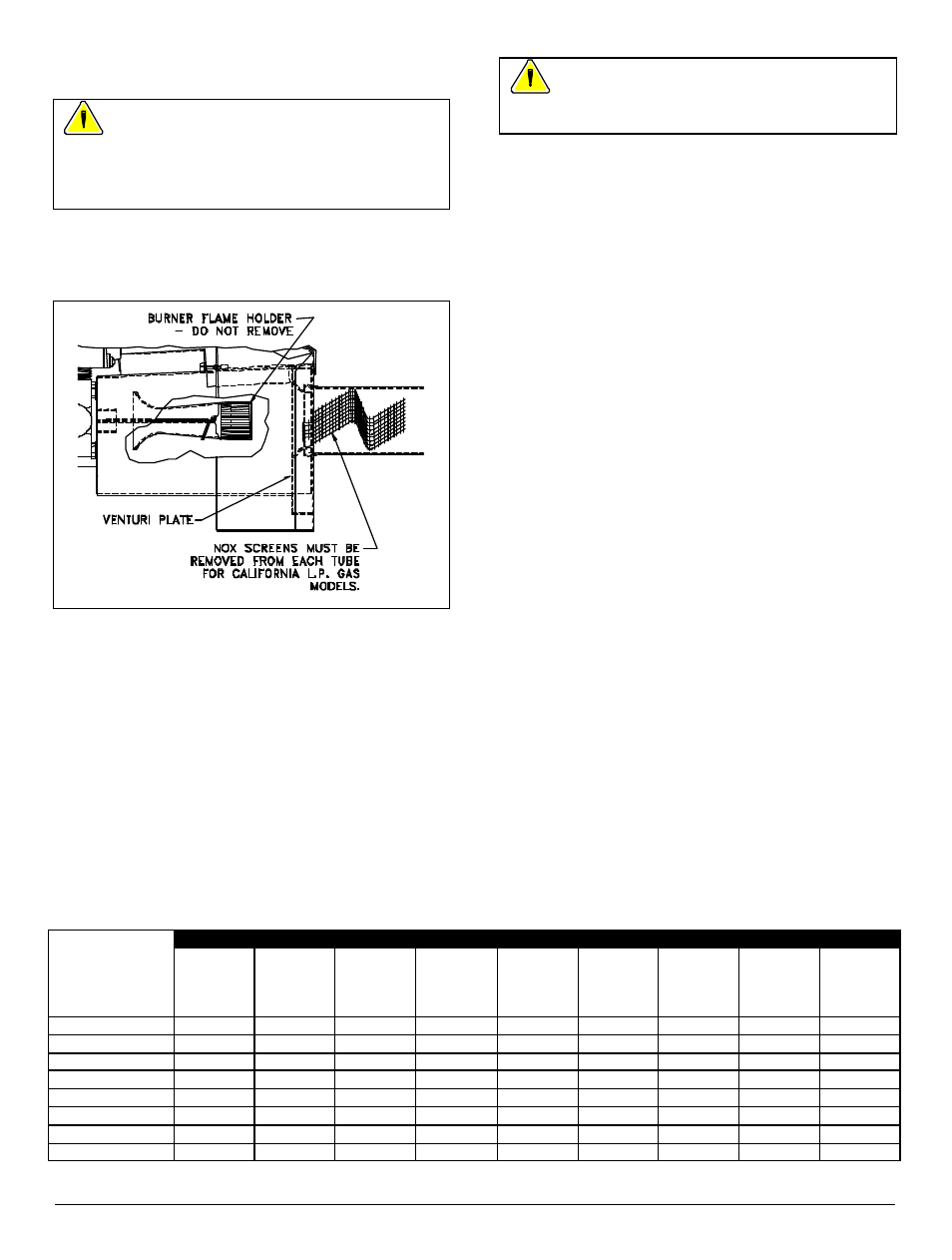Propane (lp) gas input rate – Thermo Pride Thermo Pace Downflow/Horizontal Furnace (CSA) User Manual
Page 27

Installer’s Information Manual
Page 27
PROPANE (LP) GAS INPUT RATE
WARNING: Propane (LP) gas installations do not
have gas meters to double-check input rate. Measure
manifold pressure adjustment with an accurate manometer.
Failure to accurately adjust pressure could cause heat
exchanger failure.
NOTE: NOx reducing screens must be removed from each
tube of California NOx furnaces when converting to
propane (LP) gas. See Figure 30.
Figure 30. California NOx Screen Removal.
1. Make sure you have correct pilot orifice and main
burner orifices.
2. Gas supply pressure must be between 11 and 13
inches W.C. for propane (LP) gas. See Section 12,
"Gas Supply Pressure and Pilot Adjustment."
3. Start furnace following "Operating Instructions" inside
front door.
4. Let furnace warm up for 6 minutes.
5. Adjust manifold pressure to 10.0 inches W.C. ± 0.3
inches W.C. See Section 13, "Manifold Pressure
Adjustment."
WARNING: Do not set Propane (LP) manifold
pressure at 11.0 inches W.C. It could cause heat
exchanger failure.
SECTION 15. DERATING FOR HIGH
ALTITUDE
At higher altitudes, the density of the air is lower.
Therefore, for proper combustion, the quantity of gas
burned in the furnace must be reduced. This is called
derating. Furnaces must be derated when installed at
altitudes greater than 2,000 feet above sea level.
Derating the furnace by adjusting the manifold pres sure
lower than the range specified in the Section 13, "Manifold
Pressure Adjustment" is considered to be an improper
procedure.
At elevations above 2,000 feet, the furnace must be
derated 4% for each 1,000 foot above sea level. It is the
installer’s responsibility to see that the fu rnace input rate is
adjusted properly. Derating must be achieved by reducing
the size of the main burner orifices. Choose the proper
orifices for your altitude and gas heating value from orifice
size table 7 or 8. In Canada, high-altitude models may be
available that are rated for 2,000 to 4,500 feet above sea
level.
SECTION 16. DETERMINING
CORRECT ORIFICE SIZE
See Table 7 or Table 8 to determine correct orifice size for
your gas type, gas heating value, and altitude. Natural gas
and propane (LP) gas orifice kits are available through your
supplier. Individual orifices are also available in convenient
lot sizes. To ensure proper performance, use only
manufacturer supplied orifices. To determine which orifices
are installed in fu rnace, see furnace rating plate.
Table 7. Natural Gas Orifice Size. (Millimeters)
ELEVATION
GAS
Up
2001
3001
4001
5001
6001*
7001*
8001*
9001*
HEATING
to
to
to
to
to
to
to
to
to
VALUE **
2000
3000
4000
5000
6000
7000
8000
9000
10000
(Btu/cu. ft.)
Feet
Feet
Feet
Feet
Feet
Feet
Feet
Feet
Feet
800-849
2.25
2.20
2.15
2.15
2.10
2.05
2.05
2.00
1.95
850-899
2.20
2.15
2.10
2.10
2.05
2.00
2.00
1.95
1.90
900-949
2.15
2.10
2.05
2.05
2.00
1.95
1.95
1.90
1.85
950-999
2.10
2.05
2.00
2.00
1.95
1.90
1.90
1.85
1.80
1000-1049
2.05
2.00
1.95
1.95
1.90
1.85
1.85
1.80
1.75
1050-1099
2.00
1.95
1.90
1.90
1.85
1.80
1.80
1.75
1.75
1100-1149
1.95
1.90
1.85
1.85
1.80
1.80
1.75
1.75
--
1150-1199
1.90
1.85
1.85
1.80
1.75
1.75
--
--
--
* Above 6000 feet, a high-altitude gas conversion kit must be used.
** At standard conditions: 30.0 inches Mercury, 60°F, saturated.
